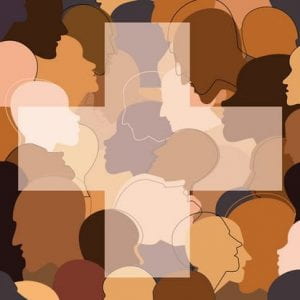Racial Disparities in Healthcare: Prevalence in Chicago During COVID Times
Author: Shubhashree Pani
Program of Study: Phd in Chemistry, Physical Sciences Division (PSD)

TED Talks | The link between health and racism. (Source: https://www.ted.com/playlists/567/the_link_between_health_and_racism)
Description: Racial discrimination in the healthcare sector in the US has been on the spotlight since a while. In this podcast, we will explore how it translates to disparities during the pandemic situation in Chicago and worldwide and possible measures to tackle it.
Listen here:
Transcript (provided by author):
Welcome to the ELI’s Finding Chicago Global Perspectives Podcast Series for AEPP 2020. I’m your host, Shubhashree Pani, and I’m currently enrolled as a graduate student in the University of Chicago’s Physical Sciences Division. Today we will be exploring the topic of Racial disparities in healthcare: Prevalence in Chicago during Covid times.
Healthcare in the United states has always been a matter of debate and discussion. While reading about the US healthcare system, as a part of my AEPP assignment, I discovered the stark racial disparities in the numbers pertaining to Covid-19.
Hailing from India, a developing nation with huge population, I have closely witnessed discrimination in healthcare. The economically backward communities, religious minorities and those belonging to lower caste often experience negligence in hospitals. In these communities, there is a higher rate of death due to preventable and curable diseases like Tuberculosis, Malaria and Diarrhoea.
However, it was quite surprising to me that being a developed nation and the land of great souls like Rosa Parks and Martin Luther King Jr., the United States is still fighting the battle of eliminating racial discrimination from the society.
Let’s have a look on these statistics as reported by CBS Chicago.
It states that black people are dying from coronavirus at a higher rate than any other population in Chicago. Though African-American constitute about 30% of the city’s population, the death rate of the community is as high as 60%. This can be partly attributed to their lower average income. As one would expect in this scenario, the neighborhoods with lower median income, which also happen to be mostly black neighborhoods, have most deaths in the city.
The scenario observed in Chicago, is just the tip of the iceberg. Contagion Live mentions that Infection rates are more than 3-fold higher and death rates are 6-fold higher in predominantly black/African American counties compared with predominantly white counties in the entire country. Hispanics/LatinX are also being disproportionately impacted. In California, LatinX represent 70% of all COVID-19 deaths in the group of people aged 18 to 49 years, despite making up just 43% of that population.
These racial/ethnic disparities are not unique to the US. In the United Kingdom, Black and South Asian individuals are at higher risk of dying from COVID-19 compared with white persons, says a study published in Nature by Williamson and group.
This reflects on the society’s disproportionate distribution of resources and this pandemic has succeeded in highlighting and magnifying the rift. The policy makers throughout the country and in different nations have imposed lockdown measures to curb the spread of the disease but have not taken adequate measures to ensure financial security of the lower-income families or the safety of the essential workers. Thus, people living hand to mouth had to go back to work despite the risk of infection just to make sure that their families don’t die of starvation. It has made poor neighborhoods where smaller appartments make it difficult to isolate sick people, more vulnerable to Covid-19 and contributed to higher death rates. In the case of millions of the “working poor”—individuals who have a job that does not provide health benefits but sadly make too much money to qualify for Medicaid—lack of access to health care has put the final nail in their coffins of hardship.
The racial disparity that is seen in Covid statistics is not the fault of those who are experiencing them, but rather the consequence of the racial oppression that started decades ago, resulting in disproportionate distribution of finances amongst different races in the society.
I believe that acknowledgement of a problem is the first step towards addressing it and I hope this podcast throws light on this issue.
As a concluding note, I would like to share an interesting piece of thought by Williams and Cooper from a recent Journal of the American Medical Association editorial. They say this is an opportunity to develop a new kind of “herd immunity.” By improving current policies and implementing new ones, making the investments necessary to decrease social determinants of health among the poor and disenfranchised, we will all be better protected from future pandemics
Thank you very much for being with me today!
References:
- Samah Assad, Dorothy Tucker, Carol Thompson, MAP: Where Are COVID-19 Deaths Happening? In Chicago, Most Are In Majority-Black Neighborhoods, CBS Chicago
- Monique Tello, Racism and discrimination in health care: Providers and patients, Harvard Health Blog, July 2020, URL: https://www.health.harvard.edu/blog/racism-discrimination-health-care-providers-patients-2017011611015
- CARLOS DEL RIO, COVID-19 and Its Disproportionate Impact on Racial and Ethnic Minorities in the United States, Contagion Live, Aug 2020, URL: https://www.contagionlive.com/publications/contagion/2020/august/covid19-and-its-disproportionate-impact-on-racial-and-ethnic-minorities-in-the-united-states
- Williams DR, Cooper LA. COVID-19 and health equity—a new kind of “herd immunity”. JAMA, May 2020. DOI:10.1001/jama.2020.8051.
- Williamson EJ, Walker AJ, Bhaskaran K, et al. OpenSAFELY: factors associated with COVID-19 death in 17 million patients. Nature July 8, 2020. https://doi.org/10.1038/s41586-020-2521-4.
Leave a Reply
You must be logged in to post a comment.